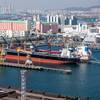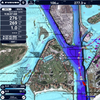As the USCG heads into the 21st century, all the surface and air assets which perform missions in the Deepwater environment (beyond 50 nautical miles from U.S. shores) are approaching the end of their respective service lives. These missions typically require either extended on-scene presence, long transit distance to reach the operating area, forward deployment of forces, or a combination of these factors.
In addition, the USCG is faced with a constrained budget. The USCG must therefore concentrate its scarce resources on an integrated system of surface, air, command, control, communications, computers, intelligence, surveillance, and reconnaissance (C4ISR) and logistics assets to maximize operational effectiveness while minimizing life-cycle costs. To accomplish this, the USCG is seeking solutions from industry in a two-phase acquisition program.
In Phase I, three project teams are developing Integrated Deepwater Systems (IDS) for the USCG. These systems will be based upon the teams' analysis of the USCG's statutory mandated missions and current and planned asset capabilities. The Phase I Contractors (project teams headed by Avondale Industries, Lockheed Martin and Science Applications International Information Corporation) will develop an IDS concept, provide specific asset performance and cost information, prepare a phased plan for the acquisition and deployment of the proposed IDS concepts and have the capability to construct individual assets in its proposed IDS concept.
Following the completion of Phase I, the USCG will select Phase I contractors to participate in Phase II where they will submit proposals with refined designs and costs to provide the system. The USCG will evaluate the Phase II proposals and award a contract to one of the contractors to build and provide the IDS.
Seven of the USCG's nine classes of deepwater assets reach the end of their planned service life in the next 15 years. The USCG Deepwater fleet of High and Medium Endurance Cutters is older than 39 of the world's 41 major naval fleets.
The Deepwater Project has been initiated to ensure the timely acquisition of the appropriate resources that will utilize available technology to satisfy the Deepwater mission needs. This project utilizes commercial and military technologies and innovation to develop a completely integrated, multimission, and highly flexible system of deepwater assets, at the lowest total ownership cost.
The Deepwater Project approach is truly unique in all of the federal government. Traditionally, major acquisition projects are focused on purchasing a single type of asset or specific service. For example, a Navy project may acquire a new class of ship, an Air Force project a new type of aircraft, or an Army project a new armored vehicle. If more than one new asset or service is needed, the agency charters separate projects for each. The Deepwater Project breaks with traditional acquisition paradigm and implements an innovative and unique Mission-Based Performance Acquisition approach.
Rather than focusing on specific hardware - like a class of cutter or aircraft - the USCG has focused on the capability to perform all of its 14 mandated missions in the deepwater region. With the focus on missions, the Project prepared a System Performance Specification describing the fundamental capabilities the service needs to carry out all 14 missions. For instance, the performance specification requires the capability to deploy boarding teams. However, it does not specify how these teams should be deployed (i.e. via small boat, aircraft, or other means).
The benefit of the Mission-Based Performance Acquisition approach is Deepwater industry teams are empowered to leverage the gamut of cutting edge technologies and processes in their design concepts. In addition, by including the full range of assets - cutters, aircraft, sensors, communications, and logistics - industry has the flexibility to develop the optimum mix of assets that comprise their Integrated Deepwater System. Another benefit of this approach is that by considering and designing deepwater assets as components of an overall Integrated Deepwater System, interoperability is built-in from the start.
The USCG delivers a broad range of services that provide immense benefits to the U.S. These services greatly enhance national security and the quality of life by improving the nation's economic vitality, maintaining law and order, ensuring safe and efficient maritime transportation, protecting natural resources, and contributing to citizen morale and confidence. They are provided to support achievement of national objectives. The USCG is defined under Title 14 of the U.S. Code (U.S.C.), and is tasked as: "…a military service and a branch of the armed forces of the U.S. at all times. The USCG shall be a service in the Department of Transportation, except when operating as a service in the Navy."
Overall, the USCG performs 14 statutorily mandated missions in the deepwater regions around the glove, which fall into four main categories: Maritime Law Enforcement, Maritime Safety, National Defense, and .
Since its creation in 1790 to enforce tariff laws, law enforcement has been a primary responsibility of the USCG. 14 UCS 89 (a) specifically gives USCG officers and petty officers the unique authority to make inspections, searches, seizures, and arrests for the prevention of violations of laws of the U.S.
Among the missions involved in Maritime Law Enforcement are
Drug Interdiction: The influx of illegal drugs is one of America's foremost national security problems. Maintaining our tradition as a front-line defense against illegal smuggling, in 1997, the Coast Guard seized more than 500 million hits of cocaine and marijuana equal to 100 million joints. These drugs had an estimated "street value" of almost $4 billion, a figure exceeding the USCG's entire 1997 budget of $3.15 billion.
Alien Migrant Interdiction: In 1994, more than 25,300 Haitian migrants were interdicted in Operation Able Manner while almost simultaneously nearly 38,600 Cuban migrants were interdicted in Operation Able Vigil. In the four years ending in December 1997, the USCG interdicted more than 17,000 other illegal migrants from 21 countries attempting to reach the U.S. by sea.
Fisheries Enforcement: The years following World War II saw an expansion in size and efficiency of global distant-water fishing fleets. In response, the Fisheries Conservation and Management Act of 1976 increased the offshore fishing area to a 200-mile zone, greatly expanding the responsibilities of the USCG.
The USCG's role as America's Lifesavers extends back to its existence as the Revenue Cutter and Life-Saving Services. Starting in 1832, cutters were directed to render assistance to vessels in distress as a specific duty. The connection between the cutters offshore and the Life-Saving Service became strong, a bond made complete with the advent of the USCG in 1915.
Among the missions involved in Maritime Safety are
Search and Rescue: In October 1980, Dutch cruise ship Prinsendam suffered a fire in the engine room 200 miles from the coast in the Gulf of Alaska. Despite rough weather conditions, four USCG one Air Force, and two Canadian helicopters rescued more than 500 shipwreck survivors from their crowded lifeboats. More recently, the USCG saves, on average, nearly 50,000 people in distress each year.
International Ice Patrol: The sinking of luxury liner Titanic in 1912 led to the creation of the International Ice Patrol. The duties of the ice patrol are to find and track icebergs and field ice, determine their set and drift, broadcast the information to merchantmen, and report the location of ice to the hydrographic office. Not a single ship has been lost to ice in the patrolled area since the creation of the ice patrol.
Following the War of Independence, the Continental Navy was disbanded, and from 1790 until 1798 the USCG served as the only national maritime force. The USCG has participated in each of the nation's military engagements since, and serves as a unique instrument of national security, as a military, multimission, maritime service within the Department of Transportation and one of the five U.S. Armed Services.
Among the missions involved in National Defense are
General Defense Operations: USCG General Defense Operations are conducted in support of Navy Aircraft Carrier Battle Groups and Marine Corps Amphibious Ready Groups. Within these groups, USCG cutters conduct a wide range of missions and tasks that contribute to the common defense and overall effectiveness of the fleet. In addition to the Maritime Defense Zone responsibility for protecting domestic ports and harbors, General Defense Operations include force protection, search and rescue, surface warfare, and anti-submarine warfare missions.
Maritime Interception Operations: A Maritime Interception Operations is a naval operation taken to compel a nation to obey international law by cutting off its foreign commerce. These operations include intercepting, boarding, searching, diverting, and/or seizing suspect vessels transiting a declared enforcement area to prevent prohibited cargo (for example, weapons or petroleum products) from being imported to or exported from that nation. Because of its recognized law enforcement and board and search expertise, the USCG has been increasingly tasked to support United Nations sanctions overseas, including in the Arabian Gulf, Red Sea, and Adriatic Sea.
Deployed Port Operations, Security and Defense: Following Desert Shield/Desert Storm, the Department of Defense expanded the USCG's Maritime Defense Zone mission to include a capability for coastal sea control and port and harbor defense in foreign operating areas. Deployed Port Operations, Security, and Defense missions and tasks ensure port and harbor areas are free of hostile threats, terrorist actions, and safety deficiencies that threaten strategic sealift and resupply operations.
Environmental Defense Operations: Environmental Defense Operations respond to incidents of marine pollution, such as the Iraqi-generated crude oil spill during Operation Desert Shield/Desert Storm, that have the potential to interfere with U.S. and allied/coalition defense operations as well as national economies and critical natural resources. Available resources for response efforts include USCG Strike Teams, oil recovery systems installed in buoy tenders, airborne sensors, and an extensive database of worldwide response capabilities.
Peacetime Military Engagement: Peacetime Military Engagement promotes stability and democracy, builds trust and friendship, and contributes to economic prosperity with a variety of governments and international organizations. USCG involvement promotes regional stability, gains access to overseas operating areas to respond to threats at their sources, and shapes coalitions with foreign governments to counter future emergencies.
The USCG's role in environmental protection dates back to the 1822 Timber Act, which tasked the Revenue Cutter Service with protecting government timber from poachers. The Oil Pollution Act of 1924, which forbade the discharge of oil into American coastal waters, tasked the Service to monitor a single environmental issue which protected the environment as a whole instead of a specific resource. Today the Coast Guard protects the critical natural resources located in the United States' 2.25 million square mile Exclusive Economic Zone (EEZ), including a wide range of prevention, protection, containment, and recovery activities and operations. These operations form the USCG's three primary environmentally related Deepwater mission areas: marine pollution enforcement and response, lightering zone enforcement, and foreign vessel inspection.
Marine Pollution Enforcement and Response: In 1973, the USCG created a National Strike Force to respond to and mitigate the effects of oil spills. Since its creation, the teams have been deployed worldwide to respond to hundreds of spill sites. The discharge of oil products and hazardous materials into the marine environment is illegal and enforcement actions are only possible through vigilant detection and investigation.
Lightering Zone Enforcement: USCG Deepwater platforms monitor and enforce lightering zones to ensure compliance with statutes and regulations. Lightering zones are designated areas established for the safe and efficient transfer of cargoes at sea. Lightering zones promote safe navigation and the safe off-loading of cargoes from ships that are too large to enter U.S. ports.
Foreign Vessel Inspection: In 1997, some 90 percent of U.S. foreign trade by tonnage - valued at nearly $1.7 trillion - moved by ship, most of it in vessels flying the flags of other countries. On average, 14 foreign vessels enter/depart U.S. ports for every U.S. vessel on an international voyage. The enforcement of international laws and treaties through the inspection of foreign vessels entering U.S. ports helps to keep substandard foreign vessels out of U.S. waters. Substandard vessels are a threat to the marine environment as well as to the port infrastructure.
At the American Shipbuilders Association: Sea Power Forum, held in February, Admiral James M. Loy addressed the issue of the Deepwater project. "Since 1790, the USCG has been the nation's expert in identifying suspicious vessels, intercepting them, boarding them, and sorting out the legitimate from the illegal…the safe from the hazardous…the friendly from the hostile - all according to the rule of law. These are USCG missions. And they are the primary reason that the USCG needs to maintain and strengthen its Deepwater capability."
According to Loy, Deepwater began four years ago with a Mission Analysis Report and a Mission Needs Statement that identified a gap between current mission capabilities and mission requirements.
"For example, our 18-knot Reliance class medium endurance cutters find it very difficult to intercept the breed of small "go-fast" smuggling boats now in vogue in parts of the Caribbean. We're stretched thin today, and tomorrow offers only more demands."
With current assets already falling short, Loy said, the requirements/capabilities gap will widen as all existing Deepwater assets - high and medium endurance cutters, larger patrol boats, C-130's, HU-25's, HH-60J's, and HH-65's - reach the end of their useful service lives over the next decade.
"We need to proceed with Deepwater because we have no other viable options to obtain the capabilities we need. You may have heard of the possibility the Navy could transfer some of their assets to us and that we could perform USCG missions with cast off FFG-7's and Cyclone class 170-ft. patrol boats.
"We've done this before with other cast off naval vessels, so we know all too well the shortcomings of the 'paint it white, add a stripe, and call it a cutter' acquisition process," Loy said.
"Instead of chasing a piece-meal, one-for-one replacement of antiquated ships and aircraft, Deepwater began with a solid analysis of the maritime environment of 2020 and the mission requirements that will define the USCG of that day. Then we carefully articulated the capabilities we will need to perform the missions we will face."
Sponsored Content
Safer Starts Here: Build Ships, Protect Crews

Subscribe for
Maritime Reporter E-News
Maritime Reporter E-News is the maritime industry's largest circulation and most authoritative ENews Service, delivered to your Email five times per week









